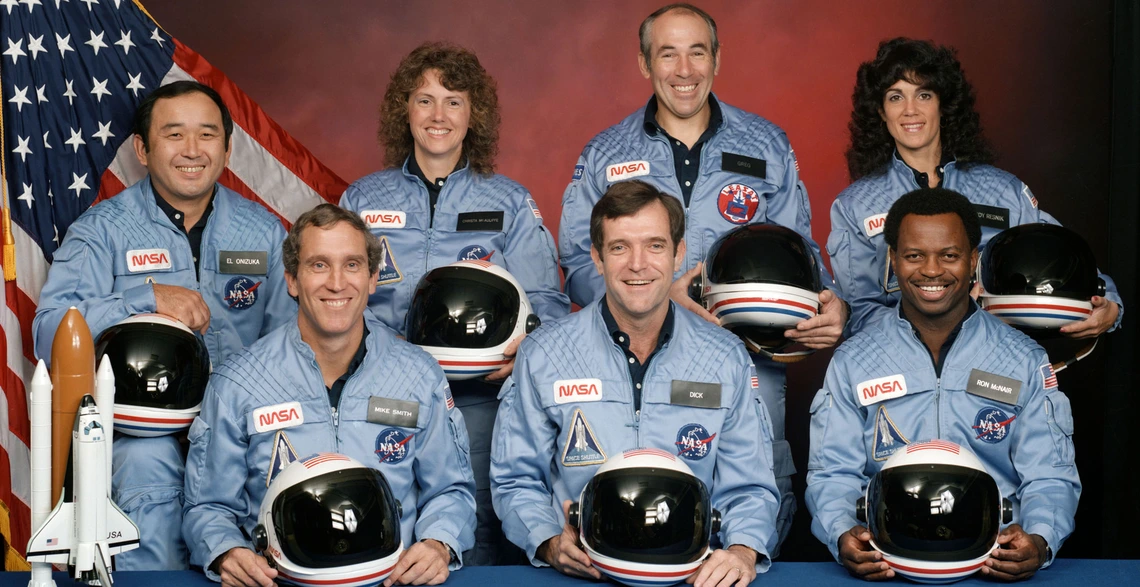UA Engineering Alum and Space Shuttle Commander Remembered at Book Signing
June Scobee Rodgers, widow of College of Engineering alumnus Dick Scobee, who died in Space Shuttle Challenger, visits campus to talk about her book and life with the shuttle commander.

Challenger crewmembers. Back row from left to right: Mission Specialist Ellison S. Onizuka, Teacher in Space participant Sharon Christa McAuliffe, Payload Specialist Greg Jarvis, and Mission Specialist Judy Resnik. Front row from left to right: Pilot Mike Smith, Commander Dick Scobee, and Mission Specialist Ron McNair.
Twenty-five years ago, on Jan. 28, 1986, Space Shuttle Challenger disintegrated just 73 seconds into its flight, causing the deaths of all seven crewmembers.
The shuttle commander that day was Richard "Dick" Scobee, who graduated in 1965 from the University of Arizona College of Engineering with a bachelor's degree in aerospace engineering. He got his pilot's wings in 1966.
In 2004, Scobee was posthumously awarded the Congressional Space Medal of Honor and was inducted into the Astronaut Hall of Fame. He was also posthumously awarded the Purple Heart medal.
Scobee's widow, June Scobee Rodgers, has written her private story -- from her winding path through childhood poverty, homelessness, and family dysfunction to her teenage marriage and 26 years of love and life with Dick Scobee, including an account of that heartbreaking day in January 1986 when her husband and his six crewmates "slipped the surly bonds of Earth."
June Scobee Rodgers will be signing and talking about her book, Silver Linings: My Life Before and After Challenger 7, at the UA student union bookstore Feb. 28, 2011, at 1 p.m.
June Scobee Rodgers is a founder of the Challenger Center for Space Science Education and an active and prominent leader in education. She is a consultant to local, state and federal education agencies, and a nationally recognized advocate for the advancement of science and math education.
"Slipping the Surly Bonds of Earth" Explained
In a broadcast to the nation following the Challenger disaster, President Reagan paraphrased a sonnet, High Flight, by John Gillespie Magee Jr., a young American airman and poet killed in World War II.
President Reagan said in his address: "We will never forget them nor the last time we saw them this morning as they prepared for their journey and waved goodbye and 'slipped the surly bonds of earth to touch the face of God.' "
Although Magee had a scholarship to Yale, he chose to slip across the border into Canada, where he joined the Royal Canadian Air Force in 1940. He was transferred to Britain, where he died in 1941 in a mid-air collision with another plane. He wrote the sonnet a few months before his death after climbing his Spitfire Mk I to 33,000 feet. The first and last lines of his sonnet are inscribed on his grave.
High Flight
Oh! I have slipped the surly bonds of Earth
And danced the skies on laughter-silvered wings;
Sunward I've climbed, and joined the tumbling mirth
Of sun-split clouds, -- and done a hundred things
You have not dreamed of -- wheeled and soared and swung
High in the sunlit silence. Hov'ring there,
I've chased the shouting wind along, and flung
My eager craft through footless halls of air. . . .
Up, up the long, delirious burning blue
I've topped the wind-swept heights with easy grace
Where never lark, or ever eagle flew --
And, while with silent, lifting mind I've trod
The high untrespassed sanctity of space,
Put out my hand, and touched the face of God.
-- John Gillespie Magee, Jr

